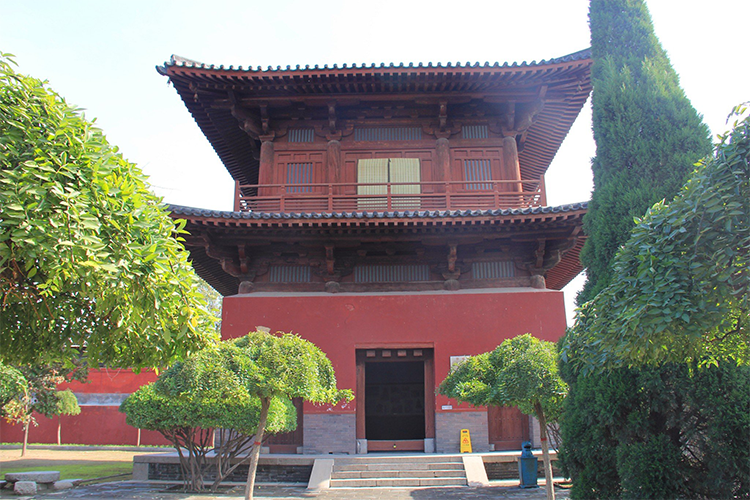Discover Kaiyuan Temple’s Song Bell Tower & Tang Pagoda
In Zhengding County, a historic center of Buddhism in northern China, Kaiyuan Temple has stood for more than 1,400 years. It preserves the rare and unique juxtaposition of a Tang-dynasty brick pagoda and a Song-dynasty wooden bell tower. Step through the gate and the nine-story Xumi Pagoda rises like a monument to the Tang era; turn and the delicate wooden bell tower reveals Song woodworking finesse. This cross-century architectural dialogue makes Kaiyuan Temple a living key to China’s ancient Buddhist architecture.
1. History: A Buddhist Treasure Through Time
Kaiyuan Temple began in 540 CE (the second year of Xinghe in the Eastern Wei), originally named Jingguan Temple . During the Sui and Tang periods it was called Jiehui Temple and was renamed Kaiyuan by imperial decree during Emperor Xuanzong’s Kaiyuan reign (713–741). As one of Zhengding’s “Eight Great Temples,” it witnessed the rise and fall of northern Chinese Buddhism from the Northern and Southern dynasties through the Qing.
Although many halls were rebuilt in the Qing era, two “treasures of the temple” have survived time: the Xumi Pagoda and the Bell Tower. This pairing is an architectural time capsule—the brick pagoda retains the Tang aesthetic of restrained grandeur, while the bell tower showcases Song-era timber craftsmanship. In 2006 Kaiyuan Temple was listed as a Major National Historical and Cultural Site for its exceptional combined layout and research value.
2. Architectural Marvels: Tang Boldness Meets Song Elegance
Xumi Pagoda: A Three-Dimensional Ode to the High Tang
The nine-story, tightly eaved brick pagoda rises to 42.5 meters, a vertical spear pointing skyward. Plain, unadorned surfaces and layered brick cornices define its clean, powerful silhouette—an embodiment of the Tang aesthetic that prized simplicity and monumentality. From the surrounding grounds (visitors cannot climb the pagoda), the old city of Zhengding unfolds, and the ancient praise that a pagoda “surges upward, solitary and lofty” still seems fitting.
Bell Tower: Song Timbercraft at Its Finest
In sharp contrast to the massive brick form is the refined two-story bell tower with a xieshan roof. Built with the Song-era “cross-column” (叉柱造) technique and elaborate mortise-and-tenon joinery, the wooden structure has endured centuries without nails. The bronze bell inside weighs about 11 tons; when struck, its deep tone can carry across half the town. If you visit at dawn, you may hear monks sounding the bell during morning recitations.
Religious Layout and Notable Features
– Tianwang Hall : The Qing-rebuilt entrance hall houses Maitreya and the Four Heavenly Kings—typical of Chinese Buddhist temple layouts.
– Pilu Hall : The main hall dedicated to Vairocana (Piluzavana), with a painted caisson ceiling and lattice windows that channel sanctified beams of light.
– Monumental Bixi Stele Base: A 107-ton stele base from the Five Dynasties carved in the likeness of a bixi , one of the dragon’s nine sons—an awe-inspiring example of ancient stone-carving power.

3. Immersive Visitor Guide
Best Times to Visit
– Early morning, 7–9 AM: Experience the resonant bell in a tranquil atmosphere; soft angled light makes the Xumi Pagoda especially photogenic.
– Avoid weekend afternoons if you prefer quiet; tour groups often arrive then.
Details You Shouldn’t Miss
– Pagoda base reliefs: Look closely at the Tang-style guardian figures carved around the base.
– Stele forest: Scattered steles across the grounds contain calligraphy by masters from different eras.
– Light and shadow: Around 3 PM the bell tower’s wooden lattice casts beautiful geometric patterns on the floor.
4. Practical Visitor Information
Address and Hours
– Address: No.109 Yanzhao South Street, Zhengding County, Shijiazhuang, Hebei Province (河北省石家庄市正定县燕赵南大街109号)
– Opening hours: 8:00–17:30 (summer extended to 18:00)
– Ticket: RMB 15 (includes combined ticket for the pagoda and nearby halls). On-site payment accepts cash and mobile payment.
Getting There
– From Shijiazhuang: Take Metro Line 1 to Huizhan Center Station , then transfer to Bus 177 to Kaiyuan Temple Station .
– By car: Navigate to “Kaiyuan Temple Parking Lot”; parking is about RMB 5 per hour.
Etiquette
– No flash photography inside halls; ask permission before photographing monks.
– Circumambulate the pagoda clockwise (a traditional Buddhist practice).
– Donation boxes are available if you wish to make an offering.

5. Nearby Cultural Itinerary
Combine Kaiyuan Temple with a full-day tour of Zhengding’s heritage:
– Morning: Longxing Temple to see the Northern Song Thousand-Armed Guanyin → Kaiyuan Temple
– Afternoon: Zhengding Ancient City Wall (climb for a view of the Four Pagodas) → Zhao Yun Temple
– Evening: Rongguo Mansion (the Dream of the Red Chamber film set) for night scenes
Standing beneath the Xumi Pagoda, you may understand why architect Liang Sicheng felt such excitement when surveying it—this is not a cold relic but a living cultural organism. The bricks and timbers of Kaiyuan Temple tell stories of faith, continuity, and enduring beauty, waiting to be read with eyes and heart.


